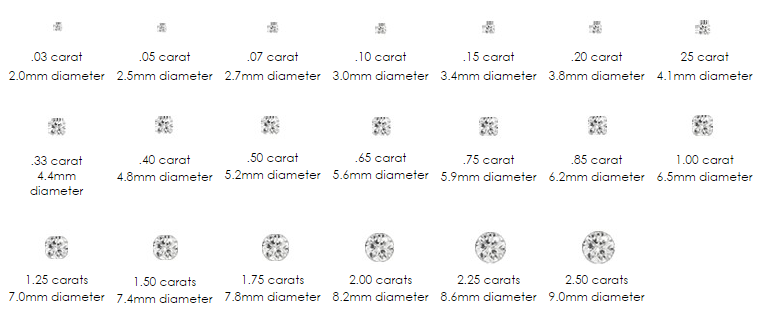The 4c’s
1. Diamond Carat
The weight of a diamond is expressed in carat. The number of carats is simply the weight of the diamond. The larger the diamond, the heavier so the more carats. A carat is divided into 100 points. The weight is determined by the diamond on a special scale. One can then simply read off the number of carats. A 0.50 Carat Diamond is half a carat or 50 punts.
The price is closely linked to the number of carats. As a diamond above the Cape of the 1 carat, increases the price exponentially. So a 0.90 carat diamond can be significantly cheaper than a similar 1.10 Carat Diamond of the same color and quality.
If you are looking for a 1 carat diamond and the price does not fit into your budget view than a diamond of around 0.95 carats. The price difference is significant and you can hardly distinguish the two from each other if you them next to each other.

2.Diamond Color
Diamonds are graded by color through a set of master stones. The diamond grader compares the color of the stone he or she sort or grade with the color of one of the stones of the master set. This is how the color of a loose diamond is graded
The best or highest possible color is the color D. There is no such thing as an A, B or C color. The scale begins with D and ends at Z. colors (D) to (H) are considered as good white colors. If you buy a diamond, try to stay within the D to H color. If a specific diamond color is a D or E and this is not within your budget, you can always check out the price compare with a G or H color. The difference in price is significantly and you still has a beautiful white diamond.
For the grading of diamond are the four c’s: color, cut, clarity and carat. This is true for both white diamond as colored diamond but the intensity of the color can significantly increase the value.

3.Diamond Clarity
All natural daimonds have traces of their growt history, as the are a product of nature. With clarity we describe a diamond’s purity. The purity indicates the appearance of the diamond. If the diamond is clear and free from inclusions, we speak of a good purity. Most of the impurities or inclusions can only be seen with a magnifying glass.
Small impurities in a diamond are acceptable. On the one hand, many people prefer a slightly larger diamond even if these impurities or inclusions. But on the other hand, and larger diamond with inclusions are worth less than a small diamond with no insluisels. This shows that the purity or clarity a very important C is.
The inclusions of a diamond are identified on the certificate that accompanies the diamond such as a fingerprint for identification can be used later even if the diamond is ever stolen.
The best purity is IF or LC what Internally Flawless or Loupe Clean State. Sometimes is also called F for Flawless used but this is actually not a good name: If there is a scratch on the diamond would come, the number formatting is no longer not Flawless. A scratch on the surface can easily be polished but the denomination IF or LC is more appropriate anyway.
Other purities are VVS (VVS1 and VVS2) what Very Very Slightly Included means, us (VS1 and VS2) what Very Slightly Included means, SI (SI1, SI2 and B3 —) what Slightly Included means and finally P (P1, P2 and P3) what Piqué means.
VVS, VS and SI diamonds have impurities that are not visible with the naked eye. The inclusions are only visible with a loupe with magnification x 10. Piqué has inclusions that are visible to the naked eye.
If you buy a diamond, try for IF or LC or VVS to choose if they fall within your budget or for us. An SI can also be good, but it depends on diamond to diamond.
It is obviously not only Cut, Carat, Color and Clarity that determine the value of a diamond. There is also one more fluorescence and the proportions of the grinding, just to name a few, but the 4 c’s are a good begin.

4.Diamond Cut
A diamond’s cut is essential to its beauty. when you cut a diamond, you adjust its proportions, symmetry and polish. The Cut is divided into 3 grades: proportions, polish and symmetry. Each grade is evaluated according to four parameters: Excellent, Very Good, Good and Fair.
The cut refers on the one hand to the shape that the diamond has. The cuts on the diamond, we call facets. The round diamond with 57 facets is the most popular and is the round brilliant cut, with us better known as brilliant. Other popular types are the emerald cut in the form of an emerald, marquise cut in the form of American football and hence by some men also called the football cut mentioned and the princess cut that square is. The princess cut is quite popular as some ladies engagement ring. It has been whispered that a man about two months salary for the engagement ring should keep in mind.
Other popular cuts are the pear shape, the oval shape and the heart shape. But they are less commen. The most sold diamonds are still the diamonds or round brilliants, diamonds with a round shape. A brilliant is a round diamond. Consequently, every brilliant is a diamond, but not every diamond is a brilliant.
On the other hand, the cut refers to the quality of the making of the diamond. Wrong or poorly placed facets can have a negative affect on the value and the quality of the diamond.


